I should, in a sense, be pleased that consumer spending is crashing.
I predicted it, so it proves me right.
And I have strong Green tinges, so surely a little less frippery should please me?
I have to say, it doesn't. This is the wrong sort of decline in consumer spending. This is caused by hardship, by failed policy, by lack of choice, by imposition on those elate able to bear the cost of recession for the benefit of those with most. Worse still, this is decline without hope. And that's desperate.
Let me explain with a long economic diversion, explaining my thinking. If you want to miss it out, there's a conclusion at the end
The world we're in revolves round this graph:

So long as things head north east we have more, and more on this graph means better.
We haven't got more right now. We've got less.That's a crisis when there's no other narrative. That leaves people without hope.
Of course there is hope. The whole logic of this graph is that is relates to what we consume - the cash part of life.
There is so much more to life than that. The whole of life is much more than the one quadrant the graph rather tellingly represents. We're whole human beings:
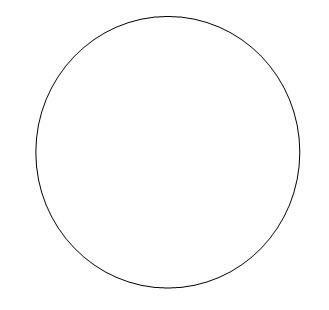
Tellingly, we're also constrained, hence the use of the circle to represent our finite limits.
Within those limits we have multiple goals. Each of us has real needs, and each of us has at the same time the potential to meet these needs in others. I suggest there are four groups of needs. They split the circle like this:
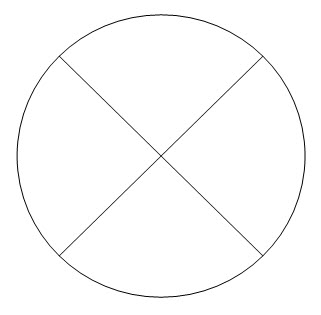
The axes are deliberately diagonal: I hated the idea that we might be back on the conventional economist's graph already. We're not. Each of these quadrants has equal positive value for example, but by using horizontal and vertical axes this might not be obvious.
Each quadrant represents a type of human need. One is for material well being. We all need air, water, food, shelter, clothing, warmth, and more besides to survive. In our modern world we believe we need much more than that.
Another is for emotion. Just start with the needs inherent in a person's relationship with their mother and move on from there: there is no one who can survive as a healthy human being without emotional relationships.
Next there is a need for intellectual development. We all need language. We must learn to provide for ourselves within the society in which we live. We are curious.
And, perhaps most contentiously (although it seems to me absolutely unambiguously), a person has a need for meaning. I call that their purpose. It could be called a spiritual need. I would be happy with that, but know that might alienate some, and I think purpose, in any event more encompassing. This is the quest for the answer to the question ‘why am I here?' Unless that question is addressed it seems pretty unlikely to me that a person can achieve their potential.
You can lay them on the diagram like this (using M = Material, E = Emotion, I = Intellectual and P — Purpose):

The allocation of the quadrants is arbitrary. It's just the one I use. Another would do just as well.
Having created the quadrant model we can add some more depth to it.
First there are two critical additional circles to draw. The first is tightly defined and will, for most people, be insignificant because of its remoteness. This is an inner circle which indicates absolute life threatening poverty. This might be caused by hunger, emotional isolation, an inability to communicate, the failure of your purpose: all can be life threatening (sometimes making people take their own lives). If a person's level of experience is reduced to this level of achievement then they are at imminent risk, probably of death. Urgent action is needed.
This state of being is indicated by this inner circle, marked A for absolute poverty here:
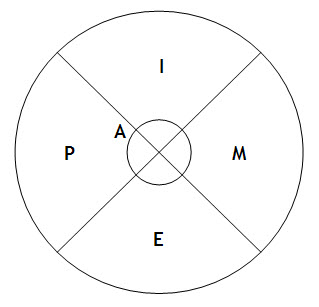
Thankfully for most people most of the time this is not an issue: they are surviving at a higher level than this. But they can still be in what society would define as relative poverty; their well being is below that which it is generally considered to be necessary to achieve a reasonable standard of living. So this justifies the addition of a second circle, between that which represents absolute poverty and that which represents a person's potential achievements. It is shown here marked R for relative poverty:
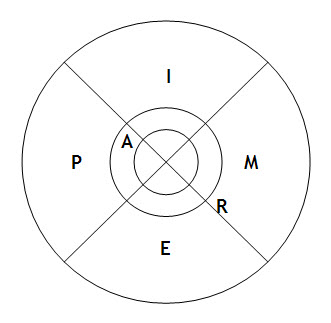
There are now three concentric circles. The innermost circle, marked A represents absolute deprivation. The area that surrounds it, marked R represents relative poverty. The area between poverty and a persons potential represents, for now, relative abundance
All of which then begs the question, where am I on this diagram? Am I achieving, or not?
I think this can be plotted, but I would add straightaway that this plotting is subjective. It might be done by the individual themselves. It could be done by someone else. In either case the result is subjective because the criteria for assessment will always be subjectively chosen in the first place.
This plotting process is helped by a desirable characteristic of a circle, which is that it offers an infinite number of radii that can be drawn within it. The reality is that out of the enormous range of choices available we will choose a very limited range of options to try. That is one of the characteristics of being constrained, if only by time, which this model explicitly recognises. For each option that we try a radius could be drawn from the centre of the circle indicating the range of achievement we had reached. Analysis could be done on those choices. I am not pursuing that line of thought now. Instead, I want to draw a line joining a person's achievements together. This becomes their area of achievement. It might look like this (and is described as C, the consequence of actions):

This is a person who is materially sufficient: they have enough to live on. They are largely emotionally satisfied. They have only two areas of relatively limited emotional concern. Their intellectual life is constrained, but only partly. They are however suffering a substantial lack of purpose and this is creating a serious threat to their well-being because they have moved into an area of absolute deprivation.
This situation is easy to translate to the reality of life as we see it. There are very many people who are materially well off and emotionally supported and who can apparently interact with society perfectly well who are nonetheless in crisis. The indication of this malaise in a person's spiritual well being is relayed through anxiety, stress and ultimately the threat off or actual practice of suicide.
The importance of the model presented here is immediately easy to see. Conventional economic models only relate to material well-being. This model defines well-being in a very different fashion whilst (as I will show in due course) being able to handle the issues that a conventional economic model addresses. The implications will be explored later. The importance should be noted now.
What the model lets us do is assess relative well-being with comparative ease. For example, this person's life is obviously unbalanced:
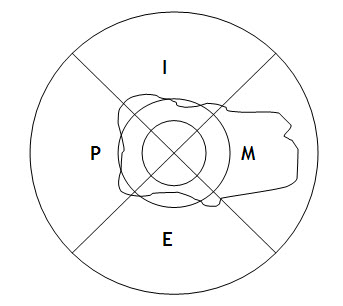
They are clearly materially well off. They have very poor social relationships despite that. It may well be that their sense of meaning is diminished as a result.
The reality is that once a person has escaped relative poverty they are almost certainly going to be better off when their activities result in reasonably balanced achievements. I could do the maths to show why that is true: I won't here, not now. These diagrams suffice. The person possessing the ellipse in this diagram (which are now smoothed for ease of presentation and with area C, the consequence of action, being highlighted in red) is better of than the person in the one that follows:
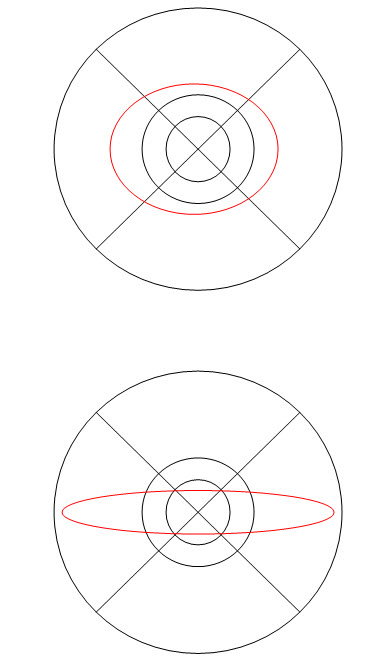
The first person may not have the peak experiences that the second one does with regard to both spiritual and material well-being but nor are they in relative poverty, or even life threatening destitution in any area of their life, but the second person is in that situation.
In fact, it is also possible to say that this person is better off than the person whose diagram follows:

Balance is best even when absolute poverty is avoided.
It is important to note that the area of achievement (C) is more complex than initially shown. It is in fact a composite of interaction at two levels. First there is an area of achievement that represents the person's contribution to well being: what they produce, what they give, what they share with others. There is a second area: what they get from society, be it material, emotional and so on. Of course one would assume they are additive and that can be the case. I enjoy my work. In the process of work I both hope I create benefit for others; I do definitely benefit myself. But the process can also be negative: a person can have constraints placed upon their ability to achieve, whether by law, lack of resources, failure to learn, lack of support, or sheer lack of purpose (the apparently brilliant person who simply wastes their talent for reason of having no idea how to focus it on anything). I won't explore this aspect of constraint now. I mention it to make clear that the area of achievement is more complex than a matter of totting up a scorecard. The area of achievement is the combination of what are in effect outward and inward flows resulting in a compromise result.
The following diagrams illustrate this for the moment:
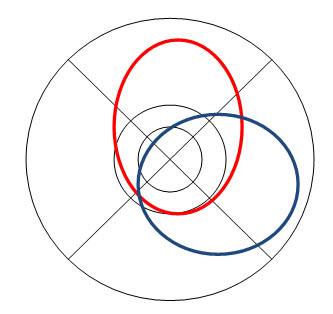
Here the red area is the person's own desired achievement. But society pulls the person in quite different ways. This person clearly seeks intellectual achievement: society (the blue area) pulls them in the direction of material well being. This might be the academic who goes to the City. And it is clear that this person's family attaches emotional reward to that material success. Neither society or the individual themselves is giving sufficient attention to the person's purpose: they are in poverty here in both diagrams.
Combine the tw0 and you get an area of actual achievement something like this:
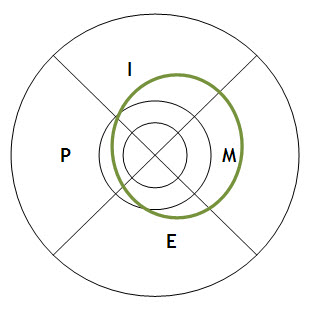
The intellectual achievement of this person has been muted: their material success enhanced. Their own conflict at the consequence reduces their emotional sense of well-being: they cannot respond to the input they receive because that input from others demands of them a response they cannot wholeheartedly give. They remain confused as to their purpose, and at risk in this area of feeling meaningless. The resulting conflict that means they neither achieve what they desire or what others desire of them, and as such actually overall are diminished in the benefit they secure from what they do compared to either input position might reflect that lack of purpose.
The key point is, once again, that balance is better. If those surrounding an individual can enhance what the individual has to offer and encourage it to flourish they will clearly be better off. If they (individually and collectively) cannot do that then the outcome detracts from the individual's well-being. That may be obvious. I suggest the diagrams help make it clear.
It is my belief that the goal of human life is to achieve one's potential: to seek to explore the possibilities available to you to the full within the constraints placed upon you. So, logically, you would want your area of achievement to approach the outer circle of your limit of possibility.
The clear implication of the model being proposed here is that the green area in the diagram is better for the person who enjoys it than the red area: it is not just that they appear to have more, they have come closer to fulfilling their potential for achievement, and that is their aim.

That though begs the question, is there a limit to possibility? And does that mean achievement is constrained? It is this question that fundamentally changes the approach used here from that offered by conventional economics at this time. Conventional thinking is that the individual should think their consumption unconstrained, even though the reality is otherwise. In the economics proposed here is the individual is recognised to be constrained they then recognise a different goal — which is to work to achieve within the constraint. And, of course, the answer is that the individual is constrained, and there is a limit to possibility that they must accept.
To some degree this is internally imposed by our finite nature.
It is also externally imposed. The simple reality is that we cannot consume without limit. The world is finite. Like us it has a beginning and an end. Of course, like us it also has a capacity to regenerate itself. But ultimately the laws of entropy apply: there is a limit to what is possible.
The calculation of that limit at a point of time would be complex, and has exercised me much over the years. Variables in the question would include some things unknown (which adds to the complexity) such as the relative age of the world. If it is now 99.9% through its period of human habitation we need not worry too much about human exploitation of resources: there will be enough to go round for all of us who remain. If, as most of us would I think hope, the life span for humans on earth might be somewhat longer than that then we might well take a different view. The state of biodiversity, the number of people on earth, the amount of energy we might receive from the sun and our ability to convert it, the state of our knowledge, both technical and in the form of wisdom (which I think much undervalued) have impact, and so on. I'll not seek to develop formulas here: suffice to say that however they fall out it is clear that at a point of time we will only have claim on a limited proportion of the material resources of the world if we are to leave the world intact for those future generations we hope to follow us.
In that case it is obvious that if we define our limit to achievement as involving the best available use of the resources available to us within the external constraints that are imposed by our own finite nature and the finite nature of the world then maximising our achievement within that constraint is not something that puts us in conflict with that finite world, it does instead mean we work with that world to realise the best that is possible in life. Seeking more within the constraints of the circle drawn here is not therefore a negative exercise — it is a positive one of achieving personal potential in a way that does not cause harm.
Two further assumptions then need be made. The first is that if this is the case the available resources of the world should be allocated equally subject to the impact of geography, which is a component factor in distribution of the benefit of those resources.
The second assumption informs the first, and is that no one has an a priori claim to well-being over another person, which is a way of saying that equality of opportunity is important, even if equality of outcome cannot be achieved.
Given these two assumptions it follows that there is a fixed material amount of resource we may each enjoy at a point in time. That defines a practical limit to achievement.
So what, you might ask ? Does the fact there are limits to achievement constrain emotional, intellectual or spiritual potential? In theory it does not. But there is a much more practical constraint on these: our own predispositions and abilities define the constraints of our own achievement in these areas. We can approach, and might even occasionally reach our potential in all three areas but we can do no more than that, for if we suggested otherwise we would simply have incorrectly defined our limits. As such in all three quadrants our achievement will be within the constraints of the outer circle that indicates the limits of our potential.
This though is not true of our potential to consume material goods. Here we do not know the limit of our own ability. We can waste that which should reasonably belong to others. We can consume that which should belong to generations that should follow us, knowingly or unknowingly. But however we look at it we can actually do this:
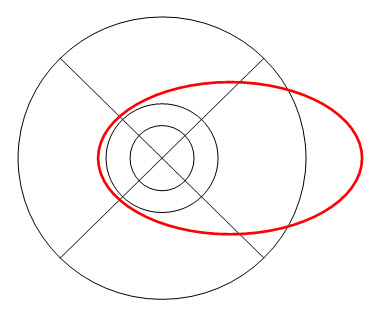
This is important. First, the fact that we can consume more than we should if we are to act either equitably or sustainably has consequences. We remain finite, even if we consume more than we should. That excess consumption does not create 26 hours in a day. It does not mean we can either receive more from or give more to our emotional relationships. In fact, the reverse is likely. The time spent consuming material goods does not just create waste in the sense that others are deprived of what is rightfully theirs: it denies us the chance to do all we might to achieve a balanced lifestyle. I propose something quite simple: to the extent that we over consume materially we constrain our ability to achieve in other aspects of our lives. The diagram looks like this:

The blue line (which should be smooth: forgive my electronic drawing ability) shows that the area of intellectual, purposeful and emotional achievement has been constrained by having sought to consume to over-capacity in the material area. And, the more we over consume the more the relative impact of that constraint is, I suggest. That is because of a simple rule that is well known to conventional economists, which is called the law of diminishing marginal returns. This is not a perfect rule: it is a model and like all models it has flaws, but within reason it holds true. It says that as one has more of something (anything, it does not matter what) the value you attribute to each additional unit of that thing you acquire falls.
Basic instinct says that this is usually true. Some would argue that cash avoids the rule because additional cash simply provides the ability to substitute between different forms of consumption. But I'm not even sure that is true: I have no doubt at all that an additional pound, euro or dollar is worth more to a person on low pay than to a person on high pay. If that is the case then relatively speaking as the excess consumption rises then the impact on emotional, intellectual and spiritual life increases until it is quite possible that it could induce a crisis in society, or in education and all through a lack of apparent meaning because consumption has become the god we worship. Does that sound familiar? The result is that over consumption gives rise to an increase in material will being and yet a loss in the overall sense of well being — call it happiness if you like. It is a phenomenon well known amongst those now observing developed economies.
Conclusion
The conclusion is relatively simple: in a world of over consumption we should be better off by reducing our spending - as may be happening now - if the allocation of that reduction in spending is fairly allocated and if if gives rise to increased capacity to fulfil the rest of our potential.
But two things are happening. First the allocation of cuts is not fair. Second, the government is ensuring that the alternative means to fulfil our potential are being withdrawn at the very time we need them - especially those relating to our intellectual potential.
Finally, and most important, this alternative narrative is not known. That means people have no clue that cutting consumption can be good for you and despair instead.
No wonder we're in a mess.
I'm willing to explore more of this if people are interested.
Thanks for reading this post.
You can share this post on social media of your choice by clicking these icons:
You can subscribe to this blog's daily email here.
And if you would like to support this blog you can, here:



Yes please. This is well worth exploring. It’s also an interesting challenge to the accepted view espoused by Abraham Maslow that views the material, emotional, intellectual and purpose components as a hierarchy.
(Oh, and when you have the time you can do the maths to show us why balanced is better)
Crickey Richard!
You’ve got all us pensioners a bit lost this time – but no doubt it is all good, sound stuff!
Brilliant post!
Well worth exploring. There’s an interesting post by Umair Haque in the Harvard Business Review, where he claims “What really caused the crisis was the fact that we didn’t care” …. “We didn’t care because we were chasing stuff. The real crisis is a crisis of nihilism: the belief that apart from stuff, nothing else matters economically.” See
http://blogs.hbr.org/haque/2010/02/the_real_roots_of_the_crisis.html
Very good and interesting. Spelling out stuff, that I vaguely know intuitively, in a nicely reasoned kind of way. It might be a bit of a digression from the usual business of this blog, but it is a worthwhile one.
A very neat presentation of a complex problem
Coincidence, just today Nicolas Hulot has declared himself for the French 2012 Presidentials. He incarnates the French Greens: the globe only has a limited amount of resources; and social-conciousness. I am waiting to see if he also will mention a more equal distribution of wealth, like his colleague Eva Joly.
I’m with everyone here – please explore. Thanks for the HBR link – it made perfect sense.